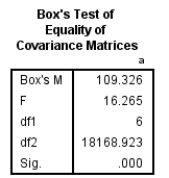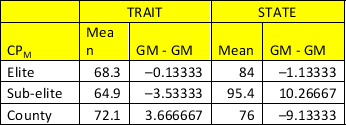Deck 17: Multivariate Analysis of Variance Manova
Question
Question
Question
Question
Question
Question
Question
Question
Question
Question
Question
Question
Question
Question
Question
Question
Question
Question
Question
Question
Question

Unlock Deck
Sign up to unlock the cards in this deck!
Unlock Deck
Unlock Deck
1/21
Play
Full screen (f)
Deck 17: Multivariate Analysis of Variance Manova
1
Why might you wish to run a discrimant analysis as opposed to an ANOVA following a MANOVA?
A) It allows the investigator to examine the nature of the relationship between two variables.
B) To reinforce the findings of the ANOVA.
C) It permits the investigator to check the distribution of the data and relate it to the dependent variables.
D) A discriminant analysis should be used in its own right and not used to supplement a MANOVA.
A) It allows the investigator to examine the nature of the relationship between two variables.
B) To reinforce the findings of the ANOVA.
C) It permits the investigator to check the distribution of the data and relate it to the dependent variables.
D) A discriminant analysis should be used in its own right and not used to supplement a MANOVA.
It allows the investigator to examine the nature of the relationship between two variables.
2
What does the result from Q20 tell us?
A) An athlete's level of competition has a significant effect on state and trait anxiety.
B) The elite athletes differed from the sub-elite athletes on trait anxiety.
C) The elite athletes differed from the county athletes on state anxiety.
D) The sub-elite athletes differed from the sub-elite athletes on trait and state anxiety.
A) An athlete's level of competition has a significant effect on state and trait anxiety.
B) The elite athletes differed from the sub-elite athletes on trait anxiety.
C) The elite athletes differed from the county athletes on state anxiety.
D) The sub-elite athletes differed from the sub-elite athletes on trait and state anxiety.
An athlete's level of competition has a significant effect on state and trait anxiety.
3
Which of the following descriptions best reflects the results from the MANOVA? 
A) The significance values are all the same so any of the test statistics could be used.
B) Use Hotelling's trace as it accounts for a significant Box test result.
C) Use Roy's largest root as it is the most powerful test.
D) Use Wilks's lambda as it is the most conservative test.

A) The significance values are all the same so any of the test statistics could be used.
B) Use Hotelling's trace as it accounts for a significant Box test result.
C) Use Roy's largest root as it is the most powerful test.
D) Use Wilks's lambda as it is the most conservative test.
Use Hotelling's trace as it accounts for a significant Box test result.
4
Calculate the CPR value based on the value above and assuming that the CPT value equals 1630.27.
A) 2326.4
B) 934.14
C) 1283.13
D) 1977.41
A) 2326.4
B) 934.14
C) 1283.13
D) 1977.41

Unlock Deck
Unlock for access to all 21 flashcards in this deck.
Unlock Deck
k this deck
5
How many independent variables are there?
A) 1
B) 2
C) 3
D) 4
A) 1
B) 2
C) 3
D) 4

Unlock Deck
Unlock for access to all 21 flashcards in this deck.
Unlock Deck
k this deck
6
Which of the following is the most appropriate explanation of the total cross-product (CPR)?
A) An evaluation of the collective relationship between the two dependent variables
B) The influence of the experimental manipulation on the relationship between the dependent variables
C) The degree of influence individual differences in participant performance have on the relationship between the dependent variables
D) The level of influence group means have on the relationship between the dependent variables
A) An evaluation of the collective relationship between the two dependent variables
B) The influence of the experimental manipulation on the relationship between the dependent variables
C) The degree of influence individual differences in participant performance have on the relationship between the dependent variables
D) The level of influence group means have on the relationship between the dependent variables

Unlock Deck
Unlock for access to all 21 flashcards in this deck.
Unlock Deck
k this deck
7
What can be ascertained from the following Box test results? 
A) A significant result which suggests that the assumption of homogeneity has been violated.
B) A significant result which suggests that the assumption of homogeneity has not been violated.
C) A non-significant result which suggests that the assumption of homogeneity has been violated.
D) A non-significant result which suggests that the assumption of homogeneity has not been violated.

A) A significant result which suggests that the assumption of homogeneity has been violated.
B) A significant result which suggests that the assumption of homogeneity has not been violated.
C) A non-significant result which suggests that the assumption of homogeneity has been violated.
D) A non-significant result which suggests that the assumption of homogeneity has not been violated.

Unlock Deck
Unlock for access to all 21 flashcards in this deck.
Unlock Deck
k this deck
8
Examine the following table. Which of the following statements best describes the data presented? 
A) State anxiety differed significantly between levels of competition, but trait anxiety did not.
B) Trait anxiety differed significantly between levels of competition, but state anxiety did not.
C) Both state and trait anxiety differed significantly between levels of competition.
D) Neither state and trait anxiety differed significantly between levels of competition.

A) State anxiety differed significantly between levels of competition, but trait anxiety did not.
B) Trait anxiety differed significantly between levels of competition, but state anxiety did not.
C) Both state and trait anxiety differed significantly between levels of competition.
D) Neither state and trait anxiety differed significantly between levels of competition.

Unlock Deck
Unlock for access to all 21 flashcards in this deck.
Unlock Deck
k this deck
9
Having obtained a significant result from a MANOVA, how would the data be examined further?
A) Multiple one-way ANOVA
B) Multiple correlations
C) Serial chi-square tests
D) Serial Kolmogorov-Smirnov tests
A) Multiple one-way ANOVA
B) Multiple correlations
C) Serial chi-square tests
D) Serial Kolmogorov-Smirnov tests

Unlock Deck
Unlock for access to all 21 flashcards in this deck.
Unlock Deck
k this deck
10
Which of the following is not an assumption of MANOVA?
A) Observations should be statistically independent
B) Random sampling from a given population
C) Measured at an ordinal level
D) Homogeneity of covariate matrices
A) Observations should be statistically independent
B) Random sampling from a given population
C) Measured at an ordinal level
D) Homogeneity of covariate matrices

Unlock Deck
Unlock for access to all 21 flashcards in this deck.
Unlock Deck
k this deck
11
Which of the following is the most appropriate explanation of the total cross-product (CPT)?
A) An evaluation of the collective relationship between the two dependent variables
B) The influence of the experimental manipulation on the relationship between the dependent variables
C) The degree of influence individual differences in participant performance have on the relationship between the dependent variables
D) The level of influence group means have on the relationship between the dependent variables
A) An evaluation of the collective relationship between the two dependent variables
B) The influence of the experimental manipulation on the relationship between the dependent variables
C) The degree of influence individual differences in participant performance have on the relationship between the dependent variables
D) The level of influence group means have on the relationship between the dependent variables

Unlock Deck
Unlock for access to all 21 flashcards in this deck.
Unlock Deck
k this deck
12
How many levels are there to the independent variable?
A) 1
B) 2
C) 3
D) 4
A) 1
B) 2
C) 3
D) 4

Unlock Deck
Unlock for access to all 21 flashcards in this deck.
Unlock Deck
k this deck
13
If multiple ANOVAs are used to follow up on a significant MANOVA result, what should be applied to the calculation to protect against Type I error?
A) Bonferroni adjustment
B) Tukey post hoc test
C) Shapiro-Wilk test
D) B and C
A) Bonferroni adjustment
B) Tukey post hoc test
C) Shapiro-Wilk test
D) B and C

Unlock Deck
Unlock for access to all 21 flashcards in this deck.
Unlock Deck
k this deck
14
If test assumptions are violated, which non-parametric test should be performed?
A) None of the tests are appropriate
B) Friedman's test
C) McNemur's test
D) Mann-Whitney test
A) None of the tests are appropriate
B) Friedman's test
C) McNemur's test
D) Mann-Whitney test

Unlock Deck
Unlock for access to all 21 flashcards in this deck.
Unlock Deck
k this deck
15
Which of the following is the most appropriate explanation of the total cross-product (CPM)?
A) An evaluation of the collective relationship between the two dependent variables
B) The influence of the experimental manipulation on the relationship between the dependent variables
C) The degree of influence individual differences in participant performance have on the relationship between the dependent variables
D) The level of influence group means have on the relationship between the dependent variables
A) An evaluation of the collective relationship between the two dependent variables
B) The influence of the experimental manipulation on the relationship between the dependent variables
C) The degree of influence individual differences in participant performance have on the relationship between the dependent variables
D) The level of influence group means have on the relationship between the dependent variables

Unlock Deck
Unlock for access to all 21 flashcards in this deck.
Unlock Deck
k this deck
16
Cross-product calculations are used to perform the MANOVA analysis, but what is the ANOVA equivalent?
A) Sum of squares
B) Levene's test
C) Crosstabulation
D) Root mean squared
A) Sum of squares
B) Levene's test
C) Crosstabulation
D) Root mean squared

Unlock Deck
Unlock for access to all 21 flashcards in this deck.
Unlock Deck
k this deck
17
Based on the results presented in Q18, what would be the most appropriate test statistic to use?
A) Pillai-Bartlett trace
B) Hotelling's T2
C) Wilks's lambda
D) Roy's largest root
A) Pillai-Bartlett trace
B) Hotelling's T2
C) Wilks's lambda
D) Roy's largest root

Unlock Deck
Unlock for access to all 21 flashcards in this deck.
Unlock Deck
k this deck
18
Analyse the data using a MANOVA and a simple contrast. What was the corresponding significance value between elite and sub-elite athletes?
A) p = .044
B) p = .006
C) p = .424
D) p = .473
A) p = .044
B) p = .006
C) p = .424
D) p = .473

Unlock Deck
Unlock for access to all 21 flashcards in this deck.
Unlock Deck
k this deck
19
Analyse the anxiety data in elite, sub-elite and county kayakers (see Q5). Calculate the CPM based on the data provided below. 
A) -696.13
B) +696.13
C) -347.13
D) 347.13

A) -696.13
B) +696.13
C) -347.13
D) 347.13

Unlock Deck
Unlock for access to all 21 flashcards in this deck.
Unlock Deck
k this deck
20
Examine the data below on state and trait sport confidence inventory (Vealey, 1986). How many dependent variables are being measured? 
A) 2
B) 3
C) 4
D) 5

A) 2
B) 3
C) 4
D) 5

Unlock Deck
Unlock for access to all 21 flashcards in this deck.
Unlock Deck
k this deck
21
Run a discriminant analysis on the data. How much variance is accounted for by the first dependent variable?
A) 100%
B) 75%
C) 50%
D) 25%
A) 100%
B) 75%
C) 50%
D) 25%

Unlock Deck
Unlock for access to all 21 flashcards in this deck.
Unlock Deck
k this deck



